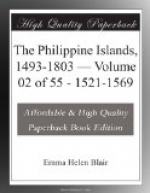articles, by a native who was on his vessel.
The general learned from hostages aboard his ship the
names of many of the islands. On the ninth of
March the fleet set sail for Mazagua, being guided
by one of these hostages. Failing to meet here
the hoped-for friendship, they determined to go to
the island of Camiguinin, [56] first setting free
all the hostages, giving them back their canoe, provisioning
it for three days, and giving many presents of clothes
to them, in order by this liberality to contract a
lasting friendship. On the eleventh of March
the coast of this island was reached. This island
“is very thickly wooded.” The natives,
as usual, fled. On the fourteenth the fleet set
sail for Butuan in Mindanao, but owing to contrary
winds, they were not able to sail that day beyond
Bohol. The patache “San Juan”
was despatched to Butuan from this place, to try to
make peace with its king and the people; and the captain
of this vessel was ordered to treat well any junks
he might meet from “China or Borneo, and other
parts.” The Malayan interpreter, Geronimo
Pacheco, was sent in this vessel, and they were ordered
to obtain as much information as possible in regard
to trade. The time given them for this expedition
was twenty-five days. News being received that
a large sail had been seen, the master-of-camp was
sent in a small boat to investigate. Two days
later he returned, reporting that the junk was from
Borneo, and that he had fought with it “for it
would not listen to peace.” In the end the
junk surrendered, and was brought in a prisoner; but
the enemy “had killed a good soldier with a
lance-thrust through the throat,” and had wounded
twenty more. The men of the junk were Moros,
and they had fought most valiantly, and “were
determined to die.” Legazpi gave the Moros
their liberty, whereat they expressed many thanks;
he gathered as much information as possible from them
in regard to the islands and peoples of these regions.
“The Moros told him that they carried iron and
tin from Borney, and from China porcelain, bells made
of copper according to their manner, benzoin, and
painted tapestry; from India pans and tempered iron
pots.” Among the captured Moros was the
pilot, “a most experienced man who had much
knowledge, not only of matters concerning these Filipinas
Islands, but of those of Maluco, Borney, Malaca, Jaba,
India, and China, where he had had much experience
in navigation and trade.” The Moros being
shown the articles of trade brought by the fleet,
advised them to go to Borneo, Siam, Patan, or Malaca,
where they could easily trade them, but “although
we wandered about these islands for ten years, we
could not dispose of so many silks, cloths, and linens.”
“This Moro told the general that two junks from
Luzon were in Butuan, trading gold, wax, and slaves....
He said that the island of Luzon is farther north
than Borney.” The Castilians learn that
the hostility and fear of the natives of these islands
is the result of a marauding expedition conducted




